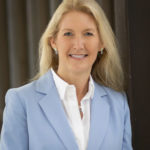Building connections with other people has always been important for Donna Hayward, principal of Haddam Killingworth High School in Connecticut, first with her family and a little later with her high-school principal, Bill Pollock, in a small, “Norman Rockwell kind of town” in Vermont where her graduating class numbered just 40 students.

Pollock, a progressive leader who left the US for a few years to build a school in Kuwait, then returned to rebuild it later after it was destroyed by a missile, made a big impression on Hayward.
“He was a fantastic high school principal, and I absolutely adored him. I remember being so incredibly inspired by that kind of commitment. He knew what he wanted to do and why he wanted to do it and was going to have an impact on these people,” she says.
Drawing on family, community bonds
Hayward’s father was a key influencer as well, always telling her that education and experience are the two things that can’t ever be taken away from you. “I happen to be very fortunate coming from a very tightknit family that valued education. I do know that not everybody has that, so our school is a family. We treat our kids like they are our own kids.”
Every school year starts with a convocation, and the whole school family comes together in the auditorium. “We talk about the successes of the previous year and goals for the current year, and I issue a personal growth challenge for the current year — what I feel like the school needs at the time,” says Hayward, who is one of three finalists for the National Association of Secondary School Principals’ Principal of the Year.
The suburban/rural school has 550 students, and the community as a whole is family-oriented and believes in personalized education experiences. “Those are two wonderful gifts, because that gives us a little space to do something extra for kids and think out of the box. I don’t have to worry about — I wouldn’t anyway — setting a precedent that the next 1,000 kids are going to want to do this now. [I can do] what this kid needs today,” she says.
Building connections helps in harder times
But in the actual today, where the US seems to be coming out the back side of the pandemic, Hayward says she and many other professionals and people in her personal life feel like “something has changed about our world.”
“First, where have all the employees gone? That’s a real challenge in terms of staffing our schools and finding high-quality teachers to teach our kids. We’ve had extremely low candidate pools. We usually have 100 candidates for an English teacher; this year we probably had a dozen. By the time I called, many had already taken jobs with other districts.
“Second, and less measurable, society — our communities — seem tired, maybe a little short-tempered, angrier after COVID. We’re all kind of experiencing this thing, this falling from civility. We’ve drifted from being civil and courteous and patient and committed to the other person in the conversation. Luckily our kids are not like that, and so a lot of the adult attention in the building is just trying to keep the positive momentum going and guard our kids from that element,” she says.
Sure, a few kids have tested the limits, usually out on the sports fields, but she says that you can go around the table with the teachers at Haddam Killingworth and ask what they like most about the school, “and universally the answers sound like, ‘The kids here are different. I don’t know how to explain it. They’re just kind. They’re committed.’ They’re very connected to the adults in the building,” she says.
Helping students see they belong
“Going back to the concept of family, when the students feel they’re part of a group, that they belong, are genuinely and truly loved, cared for, appreciated and respected, they’re going to perform better than if they don’t feel those things.
“If you read statistics around gang activity, that’s why gangs are formed. We give our kids something to belong to. We make a big deal about language: You are one of us. You are a cougar. You are part of our family. We will work together, struggle together, celebrate together. We use that language in letters home, in all-school assemblies,” she says.
The staff, after students were gone for the day, have put up every student’s name on the cafeteria walls (the only room large enough), then everyone walked around to put stickers by students they felt they had a connection with, and they also asked each student which adults in the building they feel comfortable going to if they have a problem. They’ve ensured that they’re building connections with every single child.
A whopping 85% of the students play a sport or are in a club, “so right there you have belonging. Our students are connected to the school voluntarily and are finding their peers.”
Making deeper connections with teachers, staff
Hayward and staff members are active outside the classroom too, from working with the student advisory team or the equity team and the council of all sports teams’ captains.
“Kids watching adults do what we’re asking them to do is important,” Hayward says.
They also interact in ways that help students see teachers as human beings. An all-day assembly on eliminating bias in the community “gives them voice and empowers them toward making their school a healthier and better place,” Hayward says. In one part, subgroups will each be led by a student and a teacher who’ve been trained ahead of time. The question — Think of a time when you were targeted, when you were bullied — is answered by the teachers too. “We’re all sharing a kind of common human experience and talking about how you prevent that, how you build strength around potential allies and friends who can help. The students are working next to adults, on their level, if you will.”
Building connections to improve behavior
Building connections like that at previous schools has helped Hayward better address behavioral incidents. She takes such issues seriously, tracking them with data and identifying the top offenses, then educating students about why they should change the behavior. “A few years ago, the top offense was vaping. So we put on a program of why it’s unhealthy. Then we go to the consequence side — putting vape detectors in the bathrooms — and telling them what happens if they’re caught and make it very unsavory,” she says.
In a high school that had a huge issue with tardies, they allowed students a handful of tardies and then took away their parking privileges. “Then you’re on the bus, and the bus does get here in time,” she says.
In the first district where Hayward had the biggest behavioral issues, discipline problems were cut in half over three years and by three-quarters by the time she left for a different posting.
Hayward circles back around to the importance of data: You may find that only 3% are always late or aren’t graduating, and that sounds like a good number. But all of a sudden, that 3% is a big deal when that kid is your kid, which he is when the school is a family, she says.
Gathering data and building relationships may seem difficult if your student population is far larger than 500. But while a small school has fewer kids, it also has fewer layers of staff — fewer counselors, instructional coaches, school resource officers, etc. The adult-to-student ratio is often very similar, Hayward says.
Strong relationships allow for better support
This year, one of Hayward’s biggest goals is “supporting the teachers who are pretty tired, pretty fried. Some of my strongest team members, I see them flinch, figuratively, now and then. So we tell them, ‘We’ve got this. Self-care is a big deal. So rest, regroup, know that you’re among friends, talk about what’s heavy for you right now. One step at a time, we’ll get through it,” she says.
She’ll also continue to seek out people in her region and state who she thinks would be great leaders. “What I’ve enjoyed most about receiving this recognition is the potential to help support, mentor and lead other school leaders. There are some really awesome people out there,” she says.
She already is well connected to other leaders in the state’s Shoreline Athletic Conference, which also is an academic conference. “Shoreline principals are a pretty tight group. We meet monthly to go over any issues that are coming up — How are you handling the pandemic? What are you doing about remote kids who aren’t logging on? — and we engage in a lot of group-think kind of activity,” she says. “I probably get an email every other day at a minimum where someone will throw out a question, and if you have time, you take two minutes and answer it.”
The members of the Connecticut Association of Schools have “been my people throughout my career, starting with the University of Connecticut Administrator Preparation Program. I have found them to be a very rich professional organization in terms of what they can offer for support for new administrators.” She also has been a speaker at the National Association of Secondary School Principals conference on schools and law enforcement working together.
In so many areas, Hayward continues to see how building connections pay dividends, right down to an out-of-the-blue congratulatory note and newspaper clipping about her selection as Connecticut Principal of the Year. It was Bill Pollock, her old high-school principal, reaching out — more than 30 years since she’d last seen him.
“That was super cool,” she says.
Diane Benson Harrington is an education writer at SmartBrief. Reach out to her via email, Twitter or LinkedIn.
Opinions expressed by SmartBrief contributors are their own.
_________________________
Subscribe to SmartBrief’s FREE email ASCD newsletter to see the latest hot topics in education. It’s among SmartBrief’s more than 250 industry-focused newsletters.
